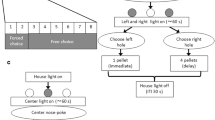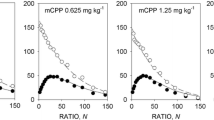Abstract
Rationale: It has been proposed that the ascending 5-hydroxytryptaminergic (5-HTergic) pathways are involved in ”impulse control”. Previous experiments have shown that rats whose 5-HTergic pathways have been destroyed are more liable than intact rats to select a smaller, immediate reinforcer rather than a larger, delayed reinforcer (impulsive choice). However, it remains unclear whether this effect of central 5-HT depletion reflects a change in the rate of time discounting (i.e. a change in the rate at which reinforcers become devalued as a function of delay) or a change in sensitivity to reinforcer size. Objective: We examined the effect of central 5-HT depletion on time discounting using a quantitative model of inter-temporal choice (multiplicative hyperbolic model), which enables effects on time discounting to be differentiated from effects on sensitivity to reinforcer size. Methods: Rats received injections of 5,7-dihydroxytryptamine into the dorsal and median raphe nuclei or sham lesions. They were trained to press two levers for food-pellet reinforcers in a discrete-trials adjusting-delay schedule. In free-choice trials, selection of lever A resulted in a brief fixed delay (d A ) followed by delivery of one pellet; selection of lever B resulted in a longer variable delay (d B ) followed by delivery of two pellets; d B was adjusted in accordance with the subject’s choices. The value of d A was varied (0.5–8.0 s) in successive phasesof the experiment, and the indifference value of d B was determined in each case. Results: In both groups, the indifference value of d B was linearly related to the value of d A ,in accordance with the multiplicative hyperbolic model. The lesioned group showed shorter indifference delays than the sham-lesioned group, this being reflected in a parallel displacement of the linear indifference function. In both experiments, the levels of 5-HT and 5-hydroxyindole-acetic acid were reduced in the brains of the lesioned rats, but the levels of noradrenaline and dopamine were not altered. Conclusions: According to the multiplicative hyperbolic model, parallel displacement of the linear indifference function uniquely specifies a change in time discounting. Thus these results indicate that central 5-HT depletion results in an increase in the rate of time discounting for food reinforcers.
Similar content being viewed by others
Author information
Authors and Affiliations
Additional information
Received: 19 October 1999 / Final version: 6 January 2000
Rights and permissions
About this article
Cite this article
Mobini, S., Chiang, TJ., Al-Ruwaitea, A. et al. Effect of central 5-hydroxytryptamine depletion on inter-temporal choice: a quantitative analysis. Psychopharmacology 149, 313–318 (2000). https://doi.org/10.1007/s002130000385
Issue Date:
DOI: https://doi.org/10.1007/s002130000385




